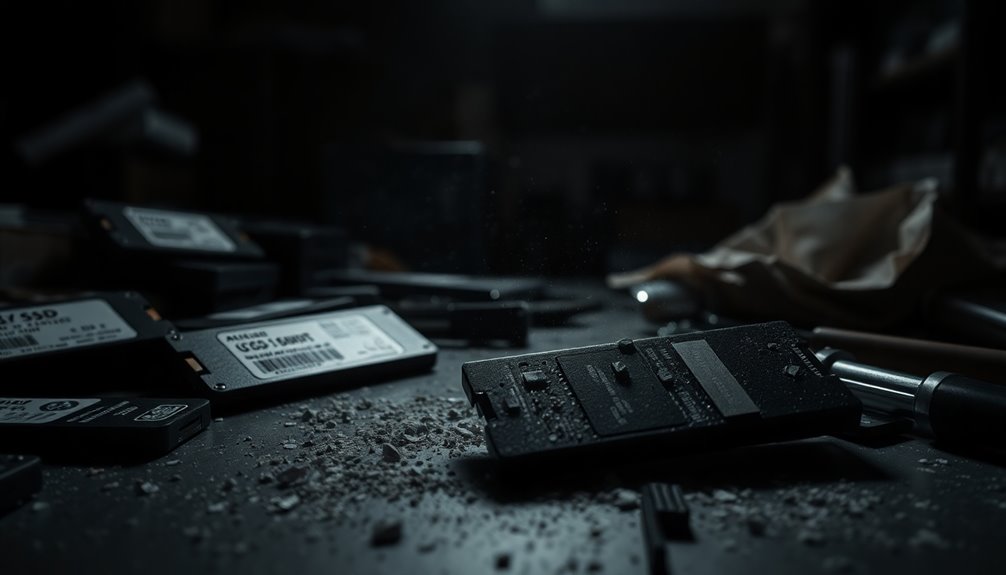You can easily create irresistibly sweet butterscotch candy at home with just a few ingredients. Start by combining brown sugar, corn syrup, and water in a saucepan. Boil it without stirring until you reach 270°F, then add butter and vanilla. Cook until it hits 300°F, then pour the mixture onto a greased baking sheet. Let it cool slightly before scoring into squares, and cool completely for the perfect texture. For a twist, consider adding nuts or spices to customize your treats. There's plenty more to help you master this delicious candy, so stick around to uncover more tips!
Key Takeaways
- Combine sugar, water, and corn syrup; boil until reaching 270°F for a soft-crack texture before adding other ingredients.
- Use a candy thermometer for precise temperature monitoring to achieve the perfect hard-candy stage at 300°F.
- Allow the butterscotch to cool completely after scoring into squares for optimal texture and ease of cutting.
- Store butterscotch in an airtight container at room temperature, using parchment paper between layers to prevent sticking.
- Customize flavors by adding nuts or spices and experimenting with different sugars for unique taste variations.
Main Ingredients

When making butterscotch candy, you'll need a few key ingredients that work together to create its delicious flavor and smooth texture. The main ingredients include butter, brown sugar, heavy cream, corn syrup, and vanilla extract. Each plays a significant role in crafting that irresistible treat.
Butter is essential for providing a creamy base, lending richness and helping the candy melt in your mouth. Brown sugar adds a deep, molasses-like sweetness that enhances the overall taste, giving your butterscotch candy its characteristic flavor.
Heavy cream is another important ingredient; it creates a velvety smooth texture that makes the candy oh-so-indulgent. Corn syrup is necessary as well, as it helps prevent crystallization during cooking, ensuring your candy stays smooth and free of graininess.
Finally, don't forget the vanilla extract. It enhances the flavor profile, adding a delightful aroma and contributing to the candy's sweet essence.
If you're feeling adventurous, you can even experiment with alternative ingredients like coconut oil or honey. These can modify the flavor or texture, allowing you to create unique variations of the classic butterscotch candy recipe.
Happy candy-making!
Preparation Instructions
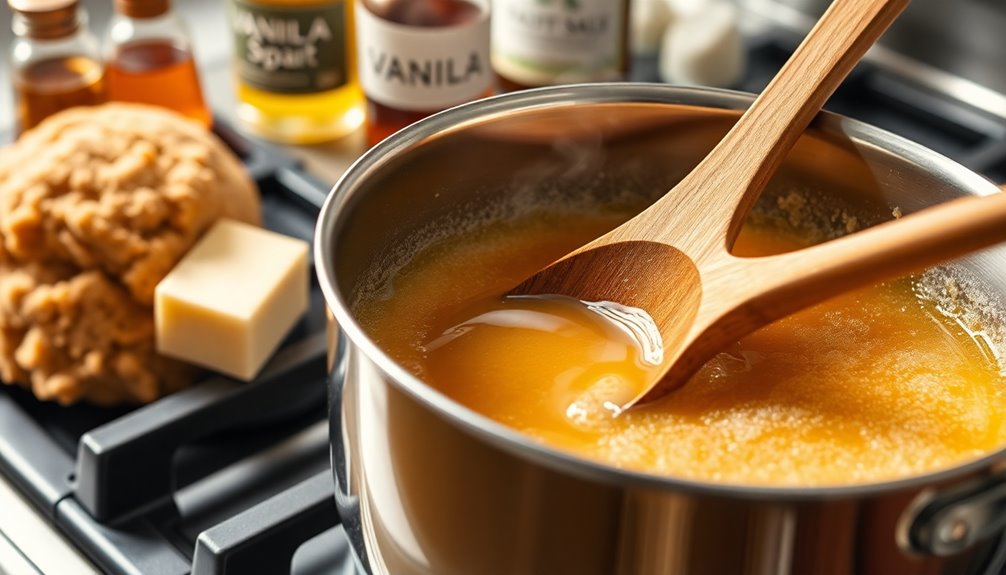
Get your candy-making essentials ready, because it's time to whip up some butterscotch goodness!
Start by prepping a 15x10x1-inch baking sheet with parchment paper. Generously butter it to prevent sticking.
In a heavy saucepan, combine sugar, water, and light corn syrup. Bring the mixture to a boil without stirring until it reaches 270°F, which is the soft-crack stage.
Once you hit that temperature, stir in honey, butter, salt, and rum extract. You'll want to keep the heat on and cook until the mixture reaches 300°F, the hard candy stage.
When it's ready, remove from the heat and carefully pour the hot mixture into your prepared baking sheet. Allow it to cool for about 5 minutes, then score the candy into squares while it's still warm.
For ideal texture, let the butterscotch candy cool completely before breaking it into pieces. This step guarantees that your treats will have the perfect crunch.
Now you're ready to enjoy your delicious homemade butterscotch treats!
Cooking Techniques

When making butterscotch candy, keeping a close eye on the temperature is essential for achieving that perfect soft-crack stage.
You'll want to stir continuously to guarantee the sugar dissolves completely, which prevents any graininess in your final product.
These techniques are key to creating a smooth and delicious candy that you'll be proud to share.
Temperature Monitoring Importance
Temperature monitoring is essential in candy making, especially for achieving the perfect butterscotch texture.
You need to be precise, as this will determine whether your butterscotch has that irresistible chewy consistency or becomes a hard, grainy mess.
Here's why you should prioritize temperature monitoring:
- Use a candy thermometer: It gives you accurate readings to guarantee your mixture reaches the right temperatures.
- Know the stages: Aim for 270°F for soft-crack and 300°F for hard-crack to achieve the desired texture.
- Prevent graininess: Cooking at the correct temperature helps sugar fully dissolve, avoiding that gritty texture you don't want.
- Avoid overcooking: Remove the mixture from heat immediately once you hit the target temperature to keep your butterscotch soft and chewy.
Mixing Techniques for Texture
Achieving the perfect butterscotch texture also relies heavily on your mixing techniques. Start by using a candy thermometer to monitor the temperature closely; you want to reach 270°F for soft-crack or 300°F for hard-crack. As you heat the sugar mixture, stir continuously to promote even cooking and prevent burning, which can ruin your candy's texture.
When adding ingredients like butter, do so gradually. This helps guarantee a smooth blend and avoids any graininess in your final product. Remember, proper mixing is key to achieving that silky butterscotch consistency.
Humidity can be a real enemy in candy making, so try to make your butterscotch on dry days. Excess moisture can lead to unwanted moisture absorption, negatively affecting your candy's firmness and overall texture.
After cooking, don't forget to allow for adequate cooling time. Let the mixture cool for at least 5 minutes before scoring; this helps set the texture properly and guarantees it's not too hard to cut.
Following these mixing techniques will help you create irresistible butterscotch candy that's perfect for sharing!
Common Issues

Making butterscotch candy can be a delightful experience, but common issues can arise that might affect your results. Here are some problems you might encounter:
- Graininess in butterscotch candy: This often stems from incomplete sugar dissolution. Verify all sugar is fully dissolved for a smooth texture.
- Overcooked candy: If your candy turns out too hard, keep an eye on the temperature. Remove it from heat once it hits 300°F (hard-crack stage).
- Humidity issues: Avoid making butterscotch candy on rainy or humid days. High humidity can lead to graininess and disrupt the proper texture.
- Candy separates: If your candy has a greasy appearance, it might be due to improper mixing. Confirm thorough incorporation of all ingredients during cooking.
If you find your candy too hard to cut, allow it to cool completely after you score the candy. If it's still tough, you can gently warm it in the oven for a few minutes to soften.
Helpful Tips
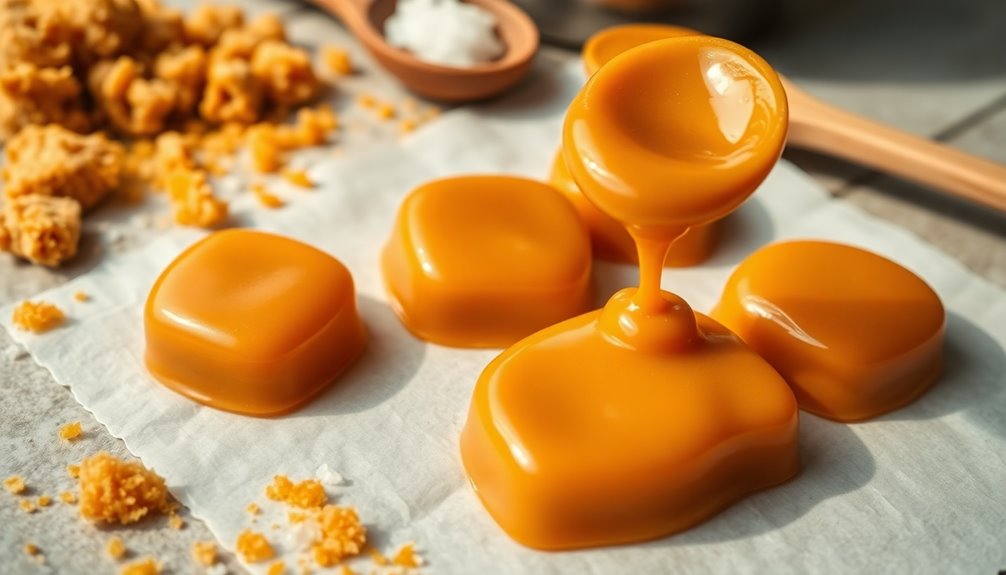
When you're diving into the world of butterscotch candy, keeping a few essential tips in mind can make all the difference. First, verify your candy thermometer's accurate by testing it in boiling water; it should read 212°F. This guarantees you'll reach the right temperatures for your homemade butterscotch candy.
To prevent graininess, dissolve the sugar completely before boiling, and don't stir once it starts bubbling.
Once your mixture is ready, pour it onto a greased baking sheet and let it cool. If it becomes too hard to cut into pieces, gently warm it in an oven at 250°F for about five minutes. This will soften the candy slightly, making it easier to handle.
For scoring, use a greased pizza wheel to create squares without cutting all the way through, which helps with breaking the pieces later.
Finally, remember to store your butterscotch candy in an airtight container at room temperature. This keeps it fresh and helps prevent stickiness or spoilage, which moisture can cause.
Recipe Variations

There are several exciting recipe variations for butterscotch candy that can elevate your homemade treat. Experimenting with these ideas not only enhances flavor but also adds a personal touch to your confection.
- Brown Sugar Substitute: Use brown sugar instead of white sugar for a deeper, molasses-like sweetness in your butterscotch flavor.
- Bold Spices Addition: Incorporate spices like ginger, cinnamon, or nutmeg to create a unique, warming flavor profile that complements the classic taste.
- Nuts Inclusion: Add chopped nuts, such as pecans or walnuts, for a delightful crunch that contrasts beautifully with the smoothness of the candy.
- Chocolate Drizzle: Finish off your cooled butterscotch candy with a rich chocolate drizzle for added visual appeal and an indulgent touch.
You can also explore flavor extracts variation by trying almond or maple extracts to introduce new dimensions to your candy. Additionally, consider using complete protein sources like nuts to boost the nutritional value of your treats.
Each of these variations allows you to customize your homemade butterscotch, making your treats even more irresistible.
Storage Guidelines
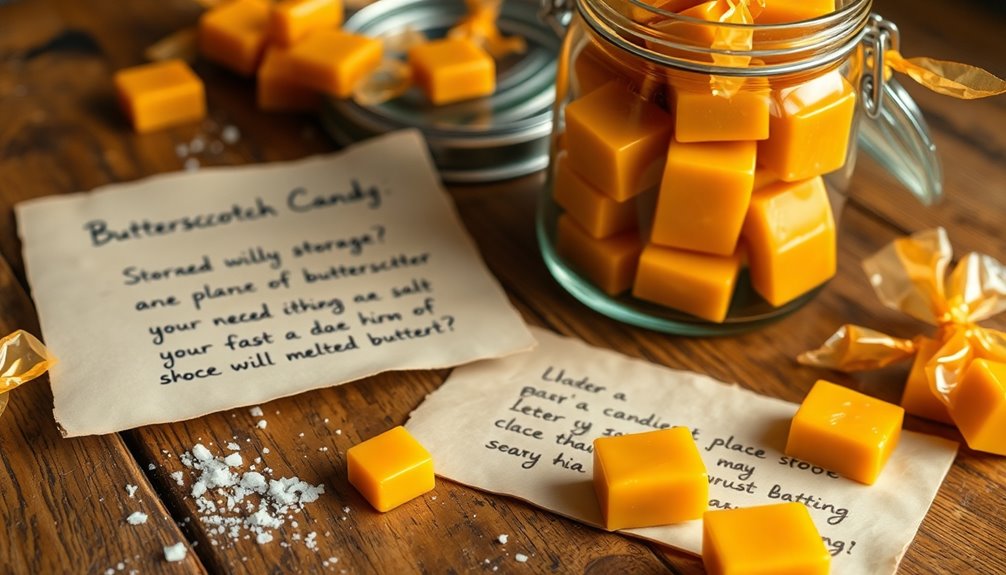
Storing butterscotch candy properly helps preserve its delicious flavor and texture. To keep your treats fresh, place them in an airtight container at room temperature. This method prevents moisture exposure, which can lead to undesirable stickiness or melting.
Make certain you store the container in a cool, dry place, away from direct sunlight and heat sources.
To avoid having your butterscotch candy pieces stick together, separate layers with parchment paper. This simple trick makes it easy to grab a piece without worrying about mess.
While it might be tempting to refrigerate your candy, avoid doing so; the moisture can cause graininess and alter the delightful texture you worked hard to achieve.
If you need to freeze your butterscotch candy, wrap each piece in wax paper to prevent sticking. However, it's generally unnecessary to freeze since the candy has a long shelf life at room temperature.
Nutritional Information
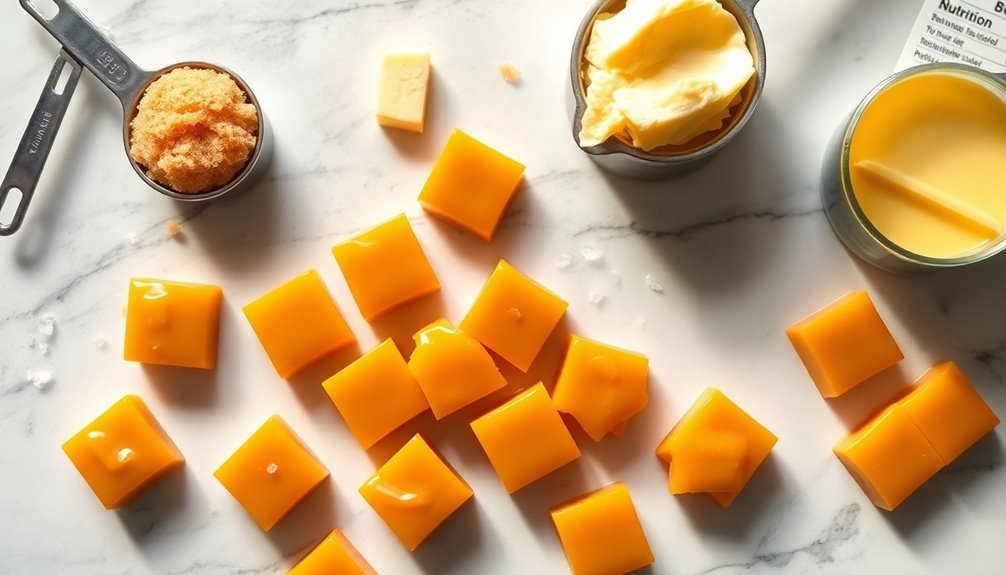
After ensuring your butterscotch candy stays fresh with proper storage, it's important to take into account its nutritional profile. Understanding the nutritional values can help you enjoy this sweet treat mindfully. Here's a quick breakdown:
- Calories: A typical serving has about 200 calories, mainly from fats and sugars.
- Sugars: You'll find around 25 grams of sugar per serving, contributing to its irresistible sweetness.
- Fat: Each serving contains about 10 grams of fat, with 6 grams being saturated fat from butter.
- Carbohydrates: Butterscotch candy packs in approximately 30 grams of carbohydrates, primarily due to the sugars used.
Keep in mind that nutritional values may vary depending on specific ingredient choices and serving sizes.
If you're watching your sugar or fat intake, consider adjusting the recipe to suit your dietary needs.
While indulging in this candy is delightful, being aware of its nutritional profile allows you to enjoy it responsibly.
Frequently Asked Questions
What Makes Butterscotch Flavoring?
Butterscotch flavoring comes from the delightful combination of brown sugar and butter, producing that rich, caramel-like taste you crave.
When you add vanilla extract, it enhances the flavor, giving it a warm sweetness. Some even toss in rum extract for an extra layer of complexity.
To achieve that creamy texture, incorporating heavy cream or milk is key.
If you want a smooth consistency, a bit of honey or corn syrup does wonders to prevent crystallization.
Can Diabetics Eat Butterscotch Candy?
Imagine munching on a vintage candy bar while pondering if diabetics can indulge in butterscotch candy.
You need to be cautious since traditional recipes are loaded with sugar, which can spike your blood sugar levels. If you're craving that sweet flavor, consider sugar-free alternatives or recipes with substitutes like erythritol.
Just remember, portion control's key! Always check with a healthcare professional for tailored advice before diving into sweet treats.
What's the Deal With Lebron James and Butterscotch Candy?
LeBron James has a sweet spot for butterscotch candy, often sharing his love for it on social media.
You might've noticed him enjoying these treats during downtime or celebrations, showcasing a lighter side to his competitive nature.
His affinity for butterscotch has even inspired merchandise, connecting his love for the flavor with fans.
Can You Melt Down Butterscotch Candy?
Imagine a golden sunset melting into the horizon; that's what melting butterscotch candy feels like.
Yes, you can melt down butterscotch candy! Just use low heat methods, like a microwave or stovetop, and watch it closely to prevent burning.
It's best to add a bit of cream or butter for that silky smooth texture.
Conclusion
Now that you've mastered the art of making butterscotch candy, enjoy the sweet rewards of your hard work! Just like a warm hug on a chilly day, these treats are sure to bring comfort and joy. Share them with friends and family, or keep them all to yourself—no judgment here! With a little practice, you'll create batches that are as delightful as they are delicious. So, roll up your sleeves and get ready to indulge!

